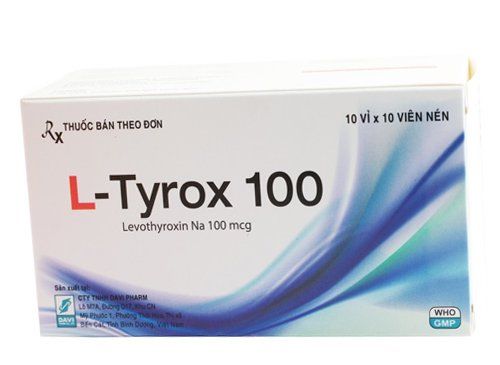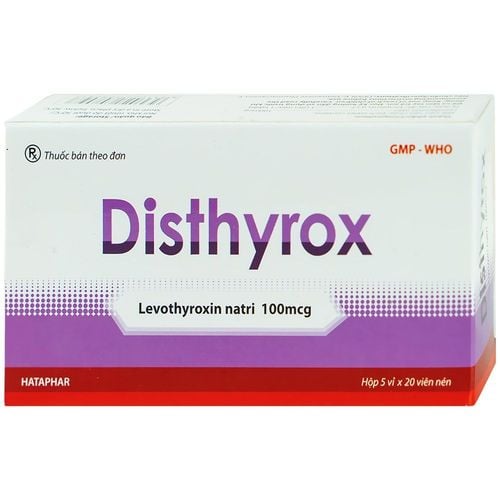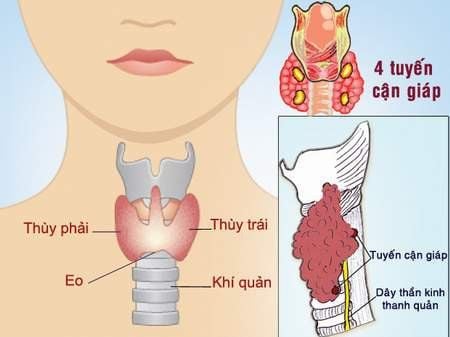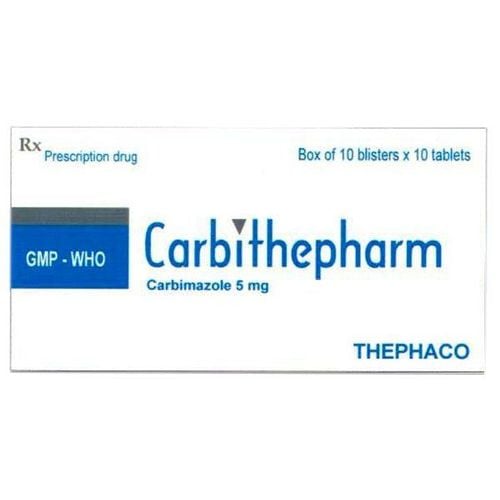This is an automatically translated article.
Tazilex is a drug used for patients preparing for thyroid surgery due to hyperthyroidism, symptoms of thyrotoxicosis, adjuvant before and during radioactive iodine treatment. It is essential to learn the basic information about Tazilex before using it to avoid unwanted side effects.1. What is Tazilex?
Tazilex medicine contains the active ingredient Methimazole. This is a synthetic antithyroid ingredient that inhibits thyroid hormone synthesis by changing the reaction of oxidizing iodide to the tyrosyl radical of the thyroglobulin molecule, and at the same time creating the iodotyrosyl molecule pairing reaction to form iodotyrosyl molecules. iodothyronine. In addition, Methimazole also inhibits the thyroid peroxidase enzyme, which prevents the oxidation of iodide and iodine tyrosine to the active form.
Also because this active ingredient does not inhibit the effect of thyroid hormone that has formed in the thyroid gland as well as does not inhibit the release of thyroid hormone. Therefore, it does not affect the effectiveness of externally administered thyroid hormone, and is not effective in the treatment of thyrotoxicosis caused by an overdose of thyroid hormone.
2. Indications and contraindications of Tazilex
2.1. Indications for use of the drug Tazilex Tazilex is indicated for use in the following cases:
Used in the treatment of symptoms of thyrotoxicosis (including Graves - Basedow's disease). Use in patients preparing for thyroid surgery due to hyperthyroidism to prevent thyrotoxicosis. Used for adjuvant treatment purposes before and during radioactive iodine treatment. Tazilex also helps to treat a bout of thyrotoxicosis prior to iodized salt. 2.2. Contraindications to use Tazilex Do not use Tazilex for patients with hypersensitivity to Methimazole or any of its ingredients, people with severe liver failure, lactating women or patients with blood diseases such as marrow failure, agranulocytosis. seed sphere.
3. Usage and dosage of Tazilex
Tazilex is used orally, patients should take the drug with a full glass of water and drink it at the same time of day with the following dosage reference:
* Tazilex dosage for adults:
Patients with hyperthyroidism Thyroid: Use the drug with a starting dose of 15mg/day for mild hyperthyroidism, 30-40mg for moderate severe cases and 60mg for severe cases, divided into 3 doses about 8 hours apart. When symptoms improve, use the drug with a maintenance dose of 5-15mg/day. Patients preparing for surgery: Use Tazilex with a starting dose of 15mg for mild hyperthyroidism, 30-40mg for moderately severe cases and increase the dose to 60mg for severe cases. However, care should be taken to stop taking the drug during surgery. Patients preparing to receive radioactive iodine: Use Tazilex with a starting dose of 15mg for patients with mild hyperthyroidism, 30-40mg for patients with moderate severity and 60mg for severe cases. It is recommended that Tazilex be discontinued 2-7 days prior to radioactive iodine administration and reinstituted approximately 3-7 days after radioactive iodine administration. After that, the patient continued to stop for about 4-6 weeks when the thyroid function was normal and the radioactive iodine was effective. Patients experiencing thyrotoxicosis: Use Tazilex at a dose of 15-20mg, every 4 hours for the first day, then adjust the dose depending on the patient's ability to respond. * Dosage of Tazilex for children:
Children with hyperthyroidism: Use the drug with a starting dose of 0.4mg/kg body weight divided into 3 doses, 8 hours apart. Then use a maintenance dose of about 1⁄2 of the starting dose. Children preparing for surgery: Use the drug with a starting dose of 0.4mg/kg body weight divided into 3 doses 8 hours apart. Tazilex should be used for about 1-2 months to normalize the thyroid gland before thyroidectomy in patients with Graves' disease and should be discontinued during surgery. Preparation for radioactive iodine use: Use the drug with a starting dose of 0.4mg/kg body weight divided into 3 oral doses 8 hours apart. The drug should be discontinued 3 to 5 days before radioiodine therapy. Basically, the above dose of Tazilex is for reference only. The specific dose of Tazilex will depend on the condition and the progress of the disease, so patients should consult their doctor or medical professional.
4. Tazilex side effects
Tazilex has a risk of causing some side effects such as:
Common: Agranulocytosis, skin rash, itching, hair loss, headache, moderate and transient fever. Uncommon: Agranulocytosis causing severe fever, chills, sore throat, cough, sore mouth, hoarse voice. Patients may experience some problems such as vasculitis, tachycardia, arthralgia, arthritis, myalgia, peripheral neuritis, nausea, vomiting, temporary loss of taste. Rare: Myelosuppression, agranulocytosis, thrombocytopenia, hypoprothrombinemia, cholestatic jaundice, hepatitis, hepatic necrosis, nephritis, interstitial pneumonia. Long-term use of drugs can produce hypothyroidism, increase the volume of goiter.
5. Drug interactions
Tazilex may interact with some of the following drugs:
Co-administration with Aminophyllin, Oxtriphylline or Theophylline will increase the metabolism of these drugs. Concomitant use with Amiodarone, glycerin iodide, iodine or potassium iodide may decrease the effectiveness of Tazilex. Concomitant use with coumarin or Indandion-derivative anticoagulants may increase the risk of hypoprothrombinemia, increasing the effect of anticoagulants. Concomitant use with beta-blockers, cardiac glycosides will increase metabolism and elimination of these drugs.
6. Be careful when taking medicine
During the course of taking the drug, if the patient has sore throat, skin rash, fever, chills, headache or general fatigue, it is necessary to check, monitor the number and formula of white blood cells to avoid this condition. granulocytosis, myelosuppression. If the examination reveals agranulocytosis, myelosuppression, fever, exfoliative dermatitis, impaired liver function, the patient should stop taking Tazilex immediately. Before administering Tazilex to patients with Graves' disease, it is recommended to check free T4 and TSH levels, complete blood count, and liver function tests. Monitor thyroid function periodically after 4-8 weeks when taking Tazilex. Thereafter, continue to monitor thyroid function every 2-3 months after taking the drug. Patients should be monitored for prothrombin time, especially before surgery because Tazilex has a risk of reducing prothrombin blood and bleeding. Basically, patients when using Tazilex need to have a specialist to prescribe treatment. In addition, during treatment, especially in the first months, patients should be carefully monitored to avoid harmful risks to health.













